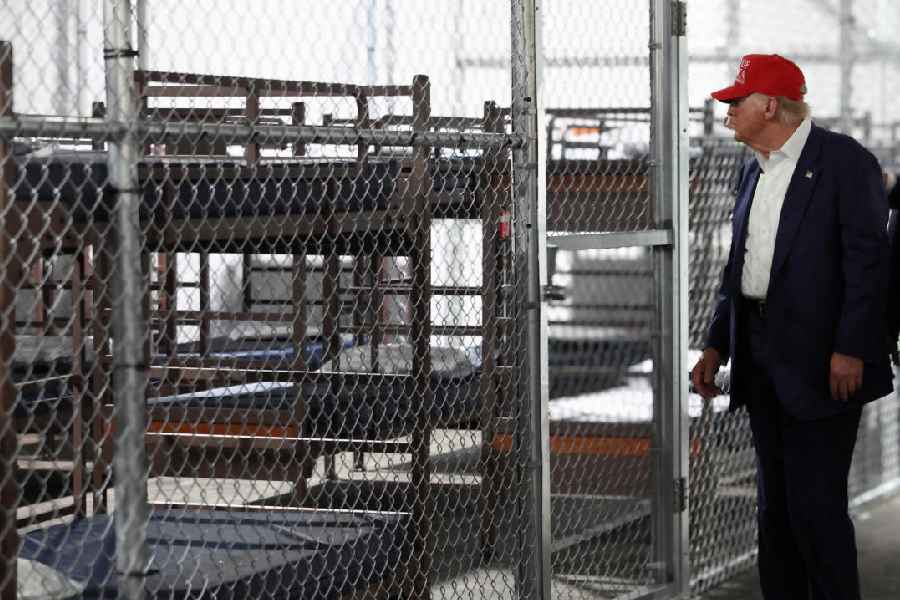Price of onion when a loaded truck from Nashik reaches Calcutta: Rs 41.85 a kg
Price when a homemaker buys onion from a city market — between Rs 60 and Rs 70 a kg
Onion remains dear in the kitchen despite claims by Delhi that prices have softened following countrywide income-tax raids on hoarders.
Metro hit the city’s prominent markets — both wholesale and retail — on Wednesday to peel off the many layers of the onion trade and find out how its price hops, skips and jumps on its journey to your kitchen.
DISTRIBUTION CHANNEL
Wholesalers at Posta Bazar in Howrah and Koley market in Sealdah get truckloads of supplies from Nashik. A few medium and small-scale wholesale markets in Shyambazar, Kidderpore, Janbazar and the Park Circus seven-point crossing also import onion or buy from bigger wholesalers. Agents and some retailers directly buy from wholesalers, while the consumer gets his onion from the retailer in the neighbourhood market.
THE WHOLESALE
The wholesale price of onion in the two largest markets — Posta and Koley — has ranged between Rs 45 and Rs 55 a kg over the past month, depending on supplies from Nashik and demand in the retail markets. The price variation among sellers is minimal as informed buyers (agents or retailers) know where to buy at the cheapest rates.
“On an average, 15 trucks have been arriving daily in the city over the past month, against a daily requirement of 50 trucks,” said Chinmoy De, a trader at Posta Bazar.
So at both Posta Bazar and Koley market, it has been a case of demand exceeding supply. “As of now, whatever arrives is sold within two hours,” said a trader at Koley market.
THE RETAIL
Price parity vanishes the moment the onion hits the retail market because buyers do not have the information retailers do about prices prevailing elsewhere. Even if they do, it doesn’t make sense for most customers to visit another market — maybe located several kilometres away — to buy a kg of onion for a few rupees less.
Metro found out that onions were being sold between Rs 60 and Rs 70 a kg on the same day in Lake Market, Gariahat, VIP Bazaar and Maniktala market. Till Monday, some retailers were charging up to Rs 80 a kg.
“Difference in quality is responsible for price variations,” insisted a trader.
The open secret is that the purchasing power of customers visiting a particular retail market more often than not determines the mark-up.
THE MARK-UP
Buying price for wholesalers? Rs 41.85 a kg for a sack of onions weighing 40kg on Wednesday.
Buying price for agents and retailers who buy directly from wholesalers? Rs 1,800 for 40kg, or Rs 45 a kg.
Buying price for retailers who get the produce through agents? Rs 1,850 for 40kg, or Rs 46.25 a kg.
Buying price for consumer? Rs 60 to Rs 70 a kg.
THE PROBLEM
The rise in onion prices has been a pan-Indian problem this winter, but more so for an onion-deficient state like Bengal. “The state barely produces one fifth of its annual requirement,” said Sarthak K. Barma, the state’s director of agriculture.
Bengal depends largely on Nashik for onion supply through the year. Between November and February, the agriculture-rich district in Maharashtra is the sole supplier of onion to Bengal. Bihar sends some consignments between May and July, while Andhra Pradesh exports its produce to Bengal between August and October.
Burdwan, Murshidabad, Nadia and North 24-Parganas are the main growers of the crop in Bengal, but the produce is inadequate. “The state’s produce meets our requirement for only a month and a half. Even then, we need back-up from Nashik,” said Khusi Raj, a veteran of the wholesale trade after five decades at Posta Bazar.
CONSUMER CRY
Consumers blame the authorities for the spike in onion price. “The government knows that we are an onion-deficient state and that scarcity peaks in winter… Then why can’t it create buffer stocks when supply is high? A planned approach can smoothen prices,” said Ardhendu Dutta, a regular at Lake Market.
MINISTER MISSIVE
Horticulture minister Mohanta Chatterjee, whose department is in charge of onion production, held “hoarding, forward trading and the Centre’s laxity” responsible.
The state’s agriculture, agriculture marketing and horticulture departments had their own vigilance mechanism and weekly reports were being submitted, he claimed, based on which the government was taking action against irregularities in pricing of most agricultural produce.
“However, in the case of onion, domestic produce is negligible. Therefore, we are dependent on central price control. The Centre has done little despite assurances to check onion prices,” minister Chatterjee told Metro.
Who do you blame for the onion price rise? Tell ttmetro@abpmail.com











